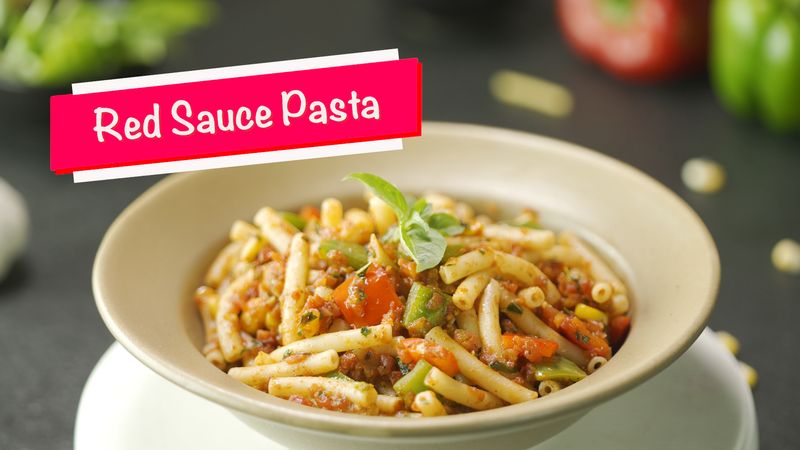Red sauce pasta, also known as marinara pasta, is a classic Italian dish that has gained immense popularity worldwide. With its rich tomato-based sauce, fragrant herbs, and tender pasta, it is a favourite among pasta enthusiasts of all ages. Whether enjoyed as a comforting weeknight dinner or served at a special gathering, red sauce pasta never fails to satisfy.
Table of contents
- Origin of Red Sauce Pasta
- Recipe for Red Sauce Pasta
- Ingredients for Red Sauce Pasta
- Instructions to make Red Sauce Pasta
- Tips for cooking
Origins and flavours
Red sauce pasta is deeply rooted in Italian culinary traditions. The dish evolved from the simple combination of pasta and tomatoes, with the addition of various herbs and seasonings to enhance the flavours. The secret to a flavorful red sauce lies in the quality of tomatoes, which should be ripe and preferably plum or San Marzano tomatoes for their intense flavour.
The sauce typically consists of sautéed onions, garlic, and herbs like basil and oregano, simmered with crushed tomatoes, and seasoned with salt, pepper, and a hint of sugar to balance the acidity. The result is a vibrant, tangy, and aromatic tomato sauce that beautifully coats the pasta, creating a comforting and satisfying meal.
Now, let's dive into the step-by-step recipe for making a delectable red sauce pasta at home. This recipe serves 4-6 portions.
Ingredients
For the pasta
- 400 grams dried pasta (spaghetti, penne, or your preferred shape)
- Water for boiling
- Salt (to season the pasta water)
For the red sauce
- 2 tablespoons olive oil
- 1 medium onion, finely chopped
- 3-4 garlic cloves, minced
- 800 grams canned crushed tomatoes
- 1 teaspoon dried basil
- 1 teaspoon dried oregano
- 1 teaspoon sugar
- Salt and pepper to taste
- Fresh basil leaves (for garnish)
Optional toppings
- Grated Parmesan cheese
- Freshly chopped parsley
Instructions
Prepare the pasta
- Fill a large pot with water and bring it to a boil. Season the water generously with salt.
- Add the dried pasta to the boiling water and cook according to the package instructions until al dente (cooked but still firm to the bite).
- Drain the cooked pasta, reserving a small cup of pasta water for later use. Set the pasta aside.
Make the red sauce
- Heat the olive oil in a large saucepan over medium heat.
- Add the finely chopped onion and sauté for 3-4 minutes until translucent.
- Stir in the minced garlic and cook for an additional minute until fragrant, being careful not to let it brown.
- Pour in the canned crushed tomatoes, dried basil, dried oregano, sugar, salt, and pepper. Stir well to combine.
- Reduce the heat to low and let the sauce simmer for about 20-25 minutes, allowing the flavours to meld together and the sauce to thicken slightly.
- If the sauce becomes too thick, you can add a small amount of the reserved pasta water to adjust the consistency.
Combine the pasta and sauce
- Add the cooked pasta to the simmering red sauce and toss gently to coat the pasta evenly with the sauce.
- Allow the pasta to cook in the sauce for a few minutes, stirring occasionally, so that it absorbs the flavours.
- Taste and adjust the seasoning if needed, adding more salt, pepper, or herbs according to your preference.
Serve the red sauce pasta
- Transfer the red sauce pasta to serving plates or a large serving bowl.
- Garnish with fresh basil leaves, grated Parmesan cheese, and freshly chopped parsley for added flavour and visual appeal.
- Serve the pasta hot and enjoy it as a standalone meal or pair it with garlic bread and a side salad for a complete and satisfying dining experience.
Pro tips
- You can customise your red sauce pasta by adding cooked vegetables such as bell peppers, mushrooms, or zucchini for added texture and nutrition.
- For a protein-rich option, you can include grilled chicken, shrimp, or ground meat in the sauce.
- If you prefer a spicier kick, add a pinch of red pepper flakes or chilli powder to the sauce.
- Fresh herbs like basil and oregano can elevate the flavours of the sauce. If available, use fresh herbs instead of dried ones for a more vibrant taste.
- Feel free to experiment with different types of pasta shapes, as each shape holds the sauce differently, offering a unique eating experience.
















